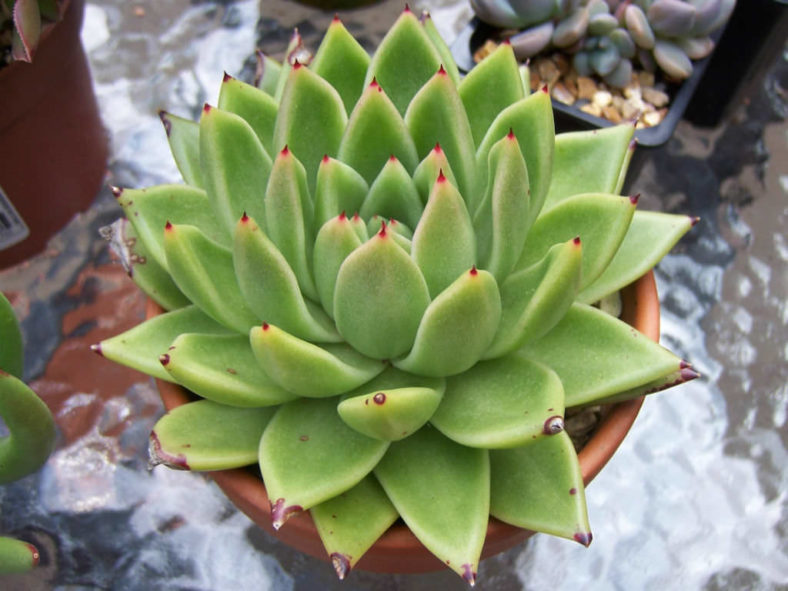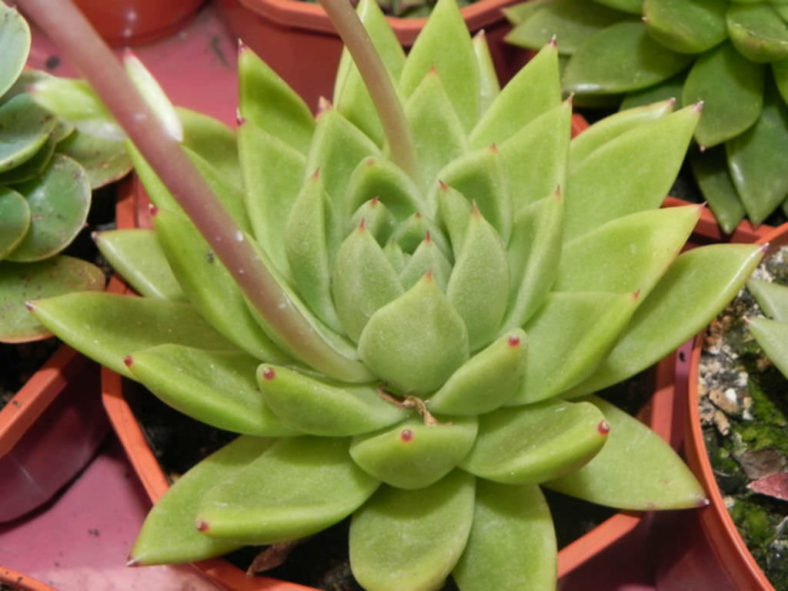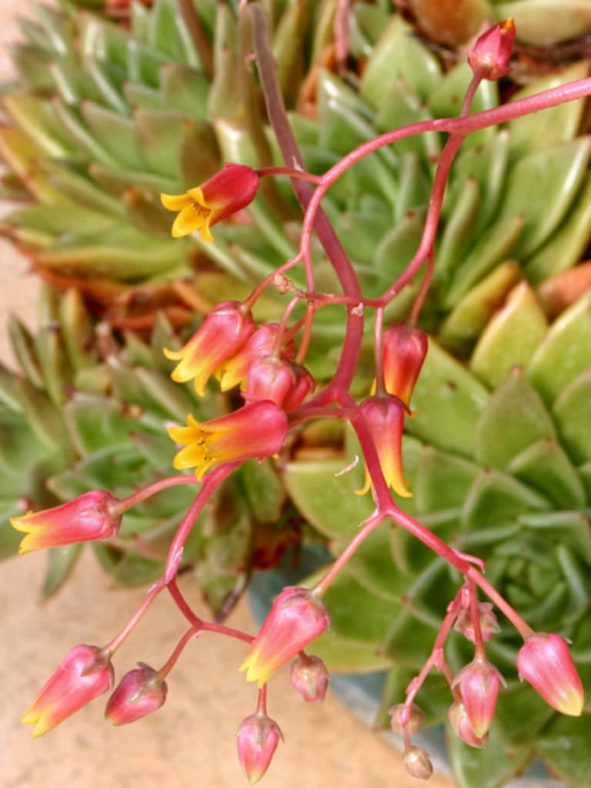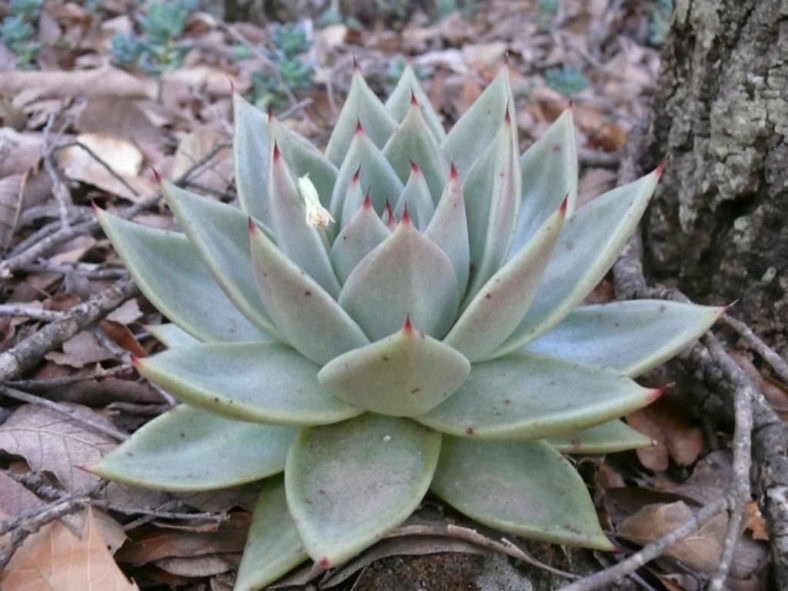Scientific Name
Echeveria agavoides Lem.
Common Name(s)
Molded Wax, Molded Wax Agave, Molded Wax Plant, Wax Agave, Wax Echeveria
Synonym(s)
Cotyledon agavoides, Echeveria obscura, Echeveria yuccoides, Urbinia agavoides, Urbinia obscura
Scientific Classification
Family: Crassulaceae
Subfamily: Sempervivoideae
Tribe: Sedeae
Genus: Echeveria
Etymology
The specific epithet "agavoides (pronounced ah-gav-OH-id-eez)" means "resembling Agave" and refers to the likeness of this species to the members of the genus Agave.
Origin
Echeveria agavoides is native to the rocky areas of Mexico.
Description
Echeveria agavoides is a stemless succulent that forms a dense, usually solitary rosette of ovate-deltoid leaves that taper to a rigid, spiny point. The rosette can reach up to 14 inches (35 cm) in diameter but is usually between 2.8 and 6 inches (7 and 15 cm). The leaves are apple green with edges that turn reddish when exposed to bright sunlight.
In spring and early summer, Echeveria agavoides produces bell-shaped flowers in 4 to 6 cymes on slender stalks with a few small bracts. The flower stalks can grow up to 12 inches (30 cm) long. The flowers are pinkish-red or orange, with petals tipped with dark yellow.

How to Grow and Care for Echeveria agavoides
Light: E. agavoides prefers full sun to partial shade. If you move your plant outside in the spring, do it gradually. The intense afternoon sun can cause sunburn. When your E. agavoides is inside during the winter, put it near the brightest window in your home. It will stretch if it does not have enough sunlight.
Soil: This succulent needs a potting soil mix that drains quickly. Many growers create their own mix, but commercial succulent potting mixes will work fine.
Hardiness: This plant is a tender succulent, which means it must be brought indoors for the winter to survive. E. agavoides can withstand temperatures as low as 25 to 50 °F (-3.9 to 10 °C), USDA hardiness zones 9b to 11b.
Watering: Provide moderate amounts of water from spring to fall. The "soak and dry" method is the preferred schedule for watering E. agavoides. If you have saucers under the pots, empty the water briefly. During winter, water the plant just enough to keep it from shriveling.
Fertilizing: E. agavoides grows well without fertilizer but may benefit from the extra nutrients. In spring, use a slow-release or liquid fertilizer diluted 2 to 4 times more than usual and used less often than recommended.
Repotting: Repot the plant only as needed during spring or early summer when it grows actively. To repot your E. agavoides, ensure the soil is dry before repotting.
Propagation: Like all Echeverias, this succulent is usually propagated from leaves and offsets, but it can also be grown from stem cuttings and seeds. Spring is the best time to take cuttings and separate offsets. Sow the seeds in spring or summer.
Learn more at How to Grow and Care for Echeveria.
Toxicity of Echeveria agavoides
E. agavoides has no reported toxic effects. It is safe around pets and humans, although it is not advisable to eat it.
Forms, Cultivars, and Hybrids of Echeveria agavoides
- Echeveria agavoides 'Aquamarine'
- Echeveria agavoides 'Corderoyi'
- Echeveria agavoides 'Corderoyi Cristata'
- Echeveria agavoides 'Cristata'
- Echeveria agavoides 'Ebony'
- Echeveria agavoides 'Maria'
- Echeveria agavoides 'Miranda'
- Echeveria agavoides 'Prolifera'
- Echeveria agavoides 'Rajoya'
- Echeveria agavoides 'Red Edge'
- Echeveria agavoides 'Romeo'
- Echeveria agavoides 'Romeo Rubin'
- Echeveria agavoides × pulidonis
- Echeveria 'Benimusume'
- Echeveria 'Celestia'
- Echeveria 'Frank Reinelt'
- Echeveria 'Gilva'
- Echeveria × gilva 'Red'
- Echeveria 'Icycle'
- Echeveria 'J.C. Van Keppel'
- Echeveria 'Haageana'
- Echeveria 'Macabeana'
- Echeveria 'Margaret Martin'
- Echeveria 'Martin'
- Echeveria 'Tippy'
- Echeveria 'Water Lily'
- ×Graptoveria 'Citrina'
Links
- Back to genus Echeveria
- Succupedia: Browse succulents by Scientific Name, Common Name, Genus, Family, USDA Hardiness Zone, Origin, or cacti by Genus
Photo Gallery
Click on a photo to see a larger version.


